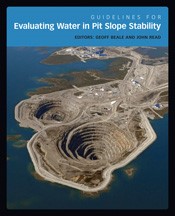This book is a comprehensive account of the hydrogeological procedures that should be followed when performing open pit slope stability design studies. The book comprises six sections which outline the latest technology and best practice procedures for hydrogeological investigations. The sections cover: the framework used to assess the effect of water in slope stability; how water pressures are measured and tested in the field; how a conceptual hydrogeological model is prepared; how water pressures are modelled numerically; how slope depressurisation systems are implemented; and how the performance of a slope depressurisation program is monitored and reconciled with the design.

Geoff Beale
John Read
Chapter Outlines
Guidelines for Evaluating Water in Pit Slope Stability (the ‘Water Book’) offers slope design practitioners a roadmap that will help them decide how to investigate and treat water pressures in pit slopes. It provides guidance and essential information for mining and civil engineers, geotechnical engineers, engineering geologists and hydrogeologists involved in the investigation, design and construction of stable rock slopes. The book is specifically designed to follow up on Chapter 6, (the Hydrogeological Model) in the LOP project’s book Guidelines for Open Pit Slope Design. The contents are divided into the six sections starting with a section that outlines the framework used to assess the effect of water in slope stability (Section 1), followed by sections outlining how the water pressures are measured and tested in the field (Section 2), how a conceptual hydrogeological model is prepared (Section 3), how water pressures are modelled numerically (Section 4), how slope depressurisation systems are implemented (Section 5), and how the performance of a slope depressurisation program is monitored and reconciled with the design (Section 6).
This section of the book outlines the framework used to assess the effect of water in slope stability. It describes the fundamental parameters used in the assessment, the key elements that make up the hydrogeological model, and general water management in open pit mines, each of which is considered in the Hydrogeological and Geotechnical Modelling phases of the slope design process.
This section of the guidelines outlines how the hydrogeological features of a mine site are characterised and reported. Section 2.1 describes how field investigation programs are planned, Section 2.2 describes how they are implemented, and Section 2.3 describes how the collected data are analysed and reported.
This section of the book outlines how a conceptual hydrogeological model is prepared. The development of a conceptual model is described in general for the mine site, but much of this chapter is focused on the development of a model that is specific to pit slopes and that can form the basis for the pore pressure predictions that will ultimately be used as input to the pit slope design process. How the conceptual model fits into the hydrogeological pathway to support the slope design is discussed in this Chapter.
Section 4 deals with the set-up and operation of numerical models and the input of pore water pressures into the slope design studies. Section 4.1 outlines how numerical models are planned, Section 4.2 describes how they are developed and Section 4.3 outlines how they are used in slope stability analyses.
The purpose of this section of the book is to outline the methods that can be used to dissipate pore water pressures in the pit slopes as part of the mining process. Section 5.1 outlines general site water management procedures, how to integrate them with the mine plan, how to manage recharge, and how to develop general dewatering and slope depressurisation targets. Section 5.2 describes the various types of depressurisation systems and the physical processes of installing and operating them. Section 5.3 outlines the factors that must be considered for integrating surface water control plans into the pit slope design.
This Chapter describes the elements of the performance monitoring system together with the periodic reviews and updates of the design criteria that are carried out as part of the monitoring and reconciliation process.

